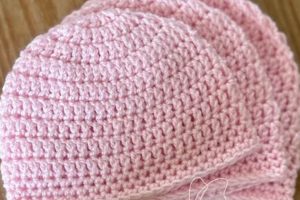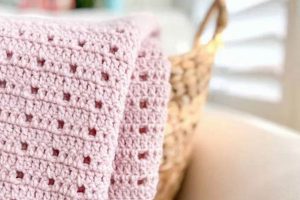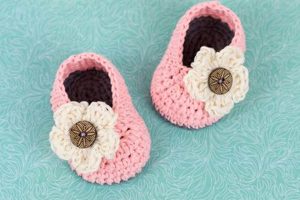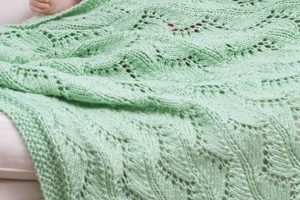Fabrics adorned with designs specifically intended for infants and young children are a common textile choice for various applications. These textiles often feature repeating motifs of animals, shapes, or themes associated with early childhood. Examples include printed cotton used for clothing, blankets, or nursery dcor.
The use of these textiles provides several benefits. The visually stimulating designs can contribute to early childhood development. Historically, the creation of such fabrics has been a significant part of textile manufacturing, evolving with changes in printing technology and aesthetic preferences. Selection often prioritizes soft, durable materials suitable for sensitive skin.
The subsequent sections will delve into specific aspects, including the materials commonly utilized, the printing techniques employed, design considerations, and safety regulations that govern the production and distribution of these textiles.
Guidelines for Selecting Textiles with Infant-Oriented Designs
This section provides essential guidelines for choosing textiles designed for use in infant and child-related products. These considerations aim to optimize safety, durability, and aesthetic appeal.
Tip 1: Prioritize Material Safety: Thoroughly review the material composition. Opt for fabrics certified as free from harmful substances, such as formaldehyde or phthalates. Look for certifications like OEKO-TEX Standard 100, which indicates testing for harmful chemicals.
Tip 2: Evaluate Fiber Content: Natural fibers like cotton and bamboo are generally preferred due to their breathability and softness. Organic cotton minimizes exposure to pesticides. Synthetic blends can offer enhanced durability, but consider potential skin sensitivities.
Tip 3: Assess Print Durability: Examine the print quality. High-quality prints are less likely to fade or bleed during washing. Consider fabrics with prints embedded within the fibers rather than surface prints, which tend to degrade more quickly.
Tip 4: Inspect for Colorfastness: Before use, test a small, inconspicuous area of the material for colorfastness. Wash the area gently with a mild detergent and observe for any color bleeding onto a white cloth. This prevents potential staining of other items.
Tip 5: Consider Washing Instructions: Review the care instructions carefully. Fabrics requiring special care or delicate washing cycles may not be practical for frequent use in infant-related items. Machine-washable and dryer-safe fabrics are generally more convenient.
Tip 6: Examine Weave Density: A tighter weave generally indicates greater durability and resistance to tearing. Inspect the weave closely, particularly if the material is intended for items subjected to heavy wear and tear.
These guidelines provide a framework for selecting textiles that meet stringent requirements for safety, longevity, and suitability in products designed for infants and young children. Adherence to these recommendations contributes to the creation of high-quality, reliable items.
The subsequent sections will elaborate on design trends, manufacturing processes, and regulatory compliance within this specialized textile market.
1. Material Safety
The selection of safe materials is paramount in the production of textiles intended for infants and young children. Regulatory bodies and consumer expectations demand stringent controls on chemical substances and physical properties to mitigate potential health risks. The characteristics of base textiles and printing processes are carefully scrutinized to ensure suitability for sensitive skin and frequent use.
- Chemical Composition and Regulations
Textiles used in infant-related products are subject to regulations that limit or prohibit the use of certain chemicals, such as formaldehyde, phthalates, and heavy metals. These substances can cause allergic reactions, skin irritation, or pose longer-term health risks. Compliance with standards like OEKO-TEX Standard 100 ensures that materials have been tested for harmful substances. Manufacturers must provide documentation verifying adherence to these regulations.
- Flammability Standards
Textiles used in sleepwear and certain other infant products must meet specific flammability standards to reduce the risk of fire-related injuries. These standards dictate the rate at which a fabric burns and the extent to which it spreads flames. Treatments applied to enhance flame resistance must themselves be non-toxic and durable through repeated washings.
- Physical Properties and Construction
Material safety also encompasses physical characteristics. Textiles should be free from small parts or embellishments that could detach and pose a choking hazard. Seams must be securely constructed to prevent unraveling. The weave density and fiber strength should be sufficient to withstand regular use and laundering without compromising structural integrity.
- Allergen Potential
Certain fibers, dyes, or finishing agents can trigger allergic reactions in sensitive individuals. Natural fibers like organic cotton or bamboo are often preferred due to their lower allergenicity compared to synthetic materials treated with harsh chemicals. Manufacturers should avoid the use of known allergens and clearly label the material composition to inform consumers.
The interconnectedness of chemical regulations, flammability standards, physical properties, and allergen potential necessitates a holistic approach to material selection. A commitment to safety ensures that these textiles provide comfort and security for infants and young children, aligning with both regulatory mandates and ethical manufacturing practices. The careful consideration of these safety aspects in the realm of infant-oriented patterned fabrics is not merely a regulatory obligation but a crucial aspect of responsible product development and consumer trust.
2. Print Durability
Print durability is a critical attribute of textiles designed for infants, directly affecting product longevity, aesthetic appeal, and overall value. The ability of a printed design to withstand repeated washing, wear, and environmental exposure is a key determinant of its suitability for use in children’s clothing, bedding, and other related items.
- Dye Penetration and Adhesion
The extent to which dyes penetrate fabric fibers and the strength of their adhesion are fundamental to print durability. Deep dye penetration ensures that the design remains vibrant even after abrasion or repeated laundering. Strong adhesion prevents dyes from bleeding or fading. Pigment printing, for example, relies on binders to adhere the pigment to the fabric surface; the quality of these binders directly impacts print wash-fastness.
- Fabric Type and Pre-Treatment
The fiber content and weave of a fabric significantly influence print durability. Natural fibers, such as cotton, may require pre-treatment to improve dye uptake and prevent color bleeding. Tightly woven fabrics offer a smoother surface for printing, resulting in sharper images and reduced ink migration. The selection of appropriate fabric types and pre-treatment processes is crucial for optimizing print longevity.
- Printing Technique and Ink Formulation
Different printing techniques, such as screen printing, digital printing, and heat transfer, yield varying degrees of print durability. Screen printing often results in thicker ink deposits, providing greater resistance to abrasion. Digital printing allows for intricate designs but may require specialized inks to achieve adequate wash-fastness. The formulation of inks, including the choice of pigments, binders, and additives, plays a pivotal role in determining overall print durability.
- Care Instructions and Consumer Practices
Print durability is also influenced by care instructions and consumer washing practices. Harsh detergents, high wash temperatures, and aggressive drying methods can accelerate print degradation. Clear and accurate care labeling is essential to inform consumers about optimal washing conditions. Adhering to recommended care guidelines can significantly extend the lifespan of printed designs on infant-related textiles.
In conclusion, the correlation between print durability and textiles intended for infants is multifaceted, encompassing dye properties, fabric characteristics, printing techniques, and consumer habits. Prioritizing durable printing methods and materials ensures that designs remain vibrant and intact, enhancing the overall quality and value of baby pattern fabric products.
3. Fiber Content
Fiber content is a foundational element determining the suitability of a textile featuring infant-oriented designs. The type of fiber used directly influences characteristics such as softness, breathability, durability, and potential for allergic reactions. For example, 100% cotton is often chosen due to its inherent softness and breathability, reducing the likelihood of skin irritation, a common concern with infant apparel and bedding. Conversely, synthetic fibers, while potentially more durable, may lack the breathability required to maintain a comfortable temperature and can sometimes cause skin sensitivity. The selection of fiber content, therefore, represents a critical decision in the manufacturing process, impacting both the comfort and safety of the end product.
The practical significance of understanding fiber content extends beyond immediate comfort. For instance, organic cotton, cultivated without synthetic pesticides or fertilizers, mitigates the risk of exposing infants to potentially harmful chemicals. This choice aligns with increasing consumer awareness regarding environmentally conscious and health-focused products. Similarly, the blend of fibers can be strategically engineered to enhance specific properties. A blend of cotton and bamboo, for example, may offer improved moisture-wicking capabilities compared to pure cotton, promoting dryness and minimizing the potential for bacterial growth. Furthermore, the fiber content impacts the textile’s ability to withstand repeated washing cycles, a crucial factor given the frequency with which infant items require laundering.
In summary, fiber content constitutes a fundamental consideration in the design and production of infant-related textiles. The selection process necessitates a careful evaluation of factors such as softness, breathability, potential allergenicity, and durability. While challenges remain in balancing cost considerations with the desire for premium, environmentally friendly materials, a thorough understanding of fiber properties empowers manufacturers to create safer, more comfortable, and longer-lasting products for infants and young children. This understanding is intrinsically linked to consumer satisfaction and the overall quality standards within the baby pattern fabric market.
4. Colorfastness
Colorfastness, defined as the resistance of a material’s color to fading or running, represents a critical performance characteristic of textiles used in infant products. Inadequate colorfastness leads to dye transfer onto a child’s skin, potential staining of other clothing during washing, and a general degradation of the product’s aesthetic appeal. The inherent properties of dyes combined with textile processing methods largely determine the level of colorfastness. Poor dye selection or improper fixation during manufacturing processes directly results in reduced colorfastness. For instance, a brightly colored cotton blanket featuring poorly fixed dyes may bleed color when exposed to moisture or during laundering, presenting both an aesthetic issue and a potential source of skin irritation.
Several factors influence colorfastness, including the type of dye used, the fiber content of the fabric, and the specific dyeing and finishing processes applied. Reactive dyes, known for their strong chemical bonds with cellulose fibers like cotton, typically exhibit superior colorfastness compared to pigment dyes, which rely on mechanical adhesion. Furthermore, darker and more saturated colors tend to be more susceptible to fading, requiring careful selection of high-quality dyes and robust fixation techniques. Real-world examples underscore the practical implications; consider the extended use of infant apparel: repeated laundering cycles necessitate exceptional colorfastness to maintain vibrancy and prevent color bleed, ensuring both durability and consumer satisfaction. Stringent testing protocols, such as those outlined by ISO 105, are essential to assess colorfastness under simulated conditions of washing, light exposure, and rubbing.
Maintaining adequate colorfastness in baby pattern fabric necessitates a holistic approach encompassing careful dye selection, optimized dyeing processes, and rigorous quality control measures. Challenges remain in balancing cost considerations with the need for high-performance dyes and environmentally sustainable practices. However, the pursuit of excellent colorfastness remains a cornerstone of responsible textile manufacturing, directly impacting product safety, consumer confidence, and the long-term value proposition of infant-related textile products. The interplay of regulatory standards, consumer expectations, and technological advancements continuously shapes the landscape of colorfastness within the baby pattern fabric market.
5. Design Aesthetics
Design aesthetics play a crucial role in textiles intended for infants and young children. These visual elements contribute significantly to consumer appeal, sensory stimulation, and developmental impact. Effective design considers age-appropriateness, cultural relevance, and emotional responses, shaping the overall product experience. The strategic application of design principles is, therefore, a critical aspect of creating successful and engaging “baby pattern fabric”.
- Color Palette Selection
The selection of colors influences mood and perception. Soft, pastel hues are often associated with tranquility and gentleness, commonly utilized in newborn apparel and bedding. Conversely, brighter, more saturated colors can stimulate visual development in older infants and toddlers. Cultural considerations also dictate color preferences, with certain colors carrying specific symbolic meanings across different societies. The intentional use of color palettes is essential for conveying the desired message and eliciting appropriate emotional responses in both children and caregivers. A design featuring high-contrast black and white patterns, for example, can be beneficial for visual development in very young infants whose color vision is still developing.
- Pattern Scale and Complexity
The size and intricacy of patterns influence visual engagement. Large, simple patterns are easier for infants to discern and can aid in early visual tracking skills. As children develop, more complex patterns can stimulate cognitive development and visual discrimination. The appropriate scaling of patterns to the size of the textile and its intended application is essential for creating visually appealing and functional products. For example, small, repetitive patterns might be suitable for smaller items such as burp cloths, while larger, bolder patterns might be used on larger items like playmats.
- Theme and Character Representation
Thematic elements and character depictions resonate with children’s interests and imaginations. Common themes include animals, nature, and geometric shapes. Character designs, whether original or licensed, can enhance emotional connection and create a sense of familiarity. The responsible use of character imagery involves ensuring age-appropriateness and avoiding potentially harmful or offensive stereotypes. A design featuring friendly, cartoon-style animals engaged in playful activities can stimulate positive emotions and create a sense of comfort. The design of a baby blanket must take into consideration if the character is age appropriate and properly vetted.
- Texture and Tactile Elements
While primarily a visual element, design aesthetics can also incorporate tactile considerations. The inclusion of textures, either through the weave of the fabric or through applied embellishments, can enhance sensory stimulation and promote tactile exploration. The selection of soft, non-irritating textures is essential for ensuring comfort and safety. Examples of tactile elements include raised embroidery, quilted patterns, or fabrics with a subtle surface texture. These elements provide additional sensory input and can contribute to a more engaging and enriching product experience.
The intersection of these design facets directly impacts the success of “baby pattern fabric”. By carefully considering color palettes, pattern scale, thematic elements, and tactile aspects, manufacturers can create textiles that are not only visually appealing but also developmentally beneficial and emotionally engaging for infants and young children. The deliberate application of design principles transforms functional fabrics into enriching sensory experiences, underlining the importance of aesthetics in creating products that support healthy development and foster a sense of comfort and security.
6. Regulatory Compliance
Regulatory compliance constitutes a fundamental aspect of producing textiles designed for infants and young children. These regulations aim to safeguard health, safety, and environmental welfare, placing specific demands on manufacturers and suppliers. Adherence to these standards is not merely a legal obligation, but also a reflection of ethical manufacturing practices and consumer responsibility. Failure to comply can result in legal repercussions, product recalls, and reputational damage.
- Chemical Restrictions
Chemical restrictions form a significant component of regulatory compliance. Certain chemical substances commonly used in textile manufacturing, such as formaldehyde, phthalates, and azo dyes, have been identified as potential health hazards. Regulations, such as those outlined by REACH (Registration, Evaluation, Authorisation and Restriction of Chemicals) in the European Union and CPSIA (Consumer Product Safety Improvement Act) in the United States, impose strict limits on the permissible levels of these substances in textiles intended for infants. For example, the use of certain flame retardants, once commonplace in children’s sleepwear, is now severely restricted due to their potential toxicity. Compliance requires rigorous testing, documentation, and supply chain management to ensure that prohibited chemicals are not present in the final product.
- Flammability Standards
Flammability standards are crucial to minimizing the risk of fire-related injuries. These standards dictate the burn rate and flame spread properties of textiles. In the United States, the Consumer Product Safety Commission (CPSC) sets mandatory flammability standards for children’s sleepwear. These standards often require fabrics to be inherently flame-resistant or treated with flame-retardant chemicals that meet specific safety criteria. For instance, tightly woven fabrics are often preferred as they tend to burn slower than loosely woven materials. Manufacturers must conduct flammability testing and maintain records to demonstrate compliance with these standards. Failure to meet flammability requirements can lead to product recalls and legal penalties.
- Labeling Requirements
Labeling requirements ensure that consumers receive accurate and comprehensive information about the textile product. Regulations mandate the inclusion of information such as fiber content, country of origin, care instructions, and any relevant safety warnings. Clear and accurate labeling enables consumers to make informed purchasing decisions and properly care for the product, thereby extending its lifespan and minimizing potential risks. For example, labeling must clearly indicate if a garment is made of organic cotton and certified by a recognized organization. Failure to comply with labeling requirements can result in fines and product seizures.
- Testing and Certification
Testing and certification provide independent verification of compliance with regulatory standards. Accredited testing laboratories conduct a range of tests to assess chemical content, flammability, colorfastness, and other relevant properties. Certification programs, such as OEKO-TEX Standard 100, provide a widely recognized assurance that a textile product has been tested for harmful substances and meets specified safety criteria. Manufacturers often rely on third-party certification to demonstrate their commitment to regulatory compliance and to build consumer trust. For example, a textile product bearing the OEKO-TEX label indicates that it has undergone rigorous testing and meets stringent safety standards. Lack of proper testing and certification can raise concerns about product safety and compliance.
The interconnectedness of chemical restrictions, flammability standards, labeling requirements, and testing and certification underscores the complexity of regulatory compliance in the production of “baby pattern fabric”. Manufacturers must navigate a landscape of evolving regulations, international standards, and consumer expectations. While compliance presents challenges, it is essential for ensuring the safety, quality, and integrity of textile products intended for infants and young children. The commitment to regulatory compliance fosters consumer confidence, protects brand reputation, and contributes to a safer marketplace for all.
Frequently Asked Questions
This section addresses common inquiries and clarifies essential aspects related to textiles designed with patterns intended for infants and young children, focusing on material properties, safety, and selection criteria.
Question 1: What are the primary safety concerns associated with patterned textiles used for infants?
The main safety concerns include the presence of harmful chemicals (e.g., formaldehyde, phthalates), flammability risks, small parts that could detach and pose a choking hazard, and potential allergens. Selecting textiles certified to meet safety standards (e.g., OEKO-TEX Standard 100) minimizes these risks.
Question 2: How can one assess the colorfastness of a baby pattern fabric before purchasing or using it?
Colorfastness can be preliminarily assessed by gently rubbing a damp, white cloth against the colored area of the fabric. If dye transfers to the cloth, the fabric may exhibit poor colorfastness. Formal testing involves standardized methods to evaluate color bleed and fading under various conditions.
Question 3: Is organic cotton always the best choice for baby-related textiles, or are there other suitable alternatives?
While organic cotton is a preferable option due to the absence of synthetic pesticides and fertilizers during cultivation, other suitable alternatives exist. Bamboo, Tencel, and certain blends of natural and synthetic fibers can offer desirable properties such as softness, breathability, and durability, provided they meet safety and certification standards.
Question 4: How does the printing method affect the durability and safety of the patterned design on baby fabric?
The printing method significantly influences durability. Screen printing often provides greater resistance to abrasion and washing due to thicker ink deposits. Digital printing allows for intricate designs but may require specialized inks to ensure adequate wash-fastness. Water-based inks are generally considered safer than solvent-based inks due to reduced chemical exposure.
Question 5: What are the key labeling requirements to look for when purchasing baby pattern fabric?
Essential labeling information includes fiber content, country of origin, care instructions, and any relevant safety certifications (e.g., OEKO-TEX). Compliance with flammability standards should also be indicated, particularly for sleepwear.
Question 6: How often should baby-related textiles be washed, and what washing practices best preserve the fabric’s integrity and safety?
Baby-related textiles should be washed frequently, especially those in direct contact with the skin. Gentle detergents, cool water, and delicate washing cycles are recommended. Avoid harsh chemicals, bleach, and high-heat drying, which can degrade fibers and diminish colorfastness.
Selecting “baby pattern fabric” requires careful consideration of material safety, durability, and regulatory compliance to ensure the well-being of infants. Evaluating the fabric’s colorfastness, printing method, and labeling information contributes to making informed purchasing decisions. Adhering to appropriate washing practices maintains the fabric’s integrity and safety over time.
The following sections will delve into emerging trends and innovations in the field of textiles designed for infants.
Conclusion
This exploration of “baby pattern fabric” has illuminated critical aspects ranging from material safety and print durability to regulatory compliance and design aesthetics. The textile’s intended use necessitates stringent considerations to protect infant health and well-being. A conscientious approach to material selection, manufacturing processes, and testing protocols remains paramount.
The intersection of evolving consumer demands, regulatory landscapes, and technological advancements will continue to shape the future of this specialized textile market. Prioritizing safety, sustainability, and ethical manufacturing practices is not merely a commercial imperative, but a societal responsibility. Continued vigilance and informed decision-making will ensure that “baby pattern fabric” contributes positively to infant care and development.







